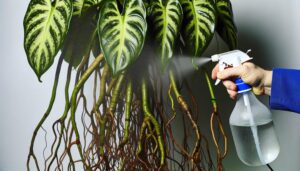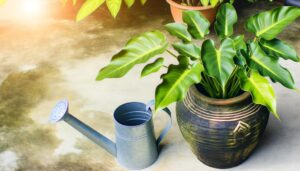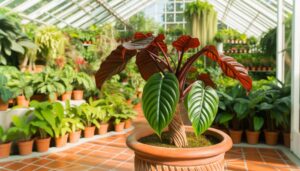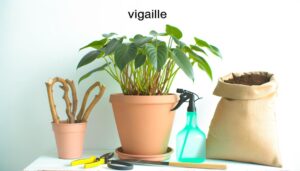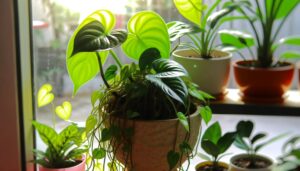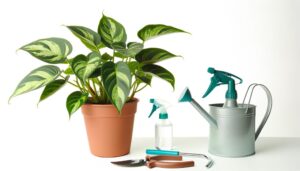What Are the Care Requirements for Philodendron Bipinnatifidum?
Philodendron bipinnatifidum thrives in bright, indirect light and well-draining soil enriched with organic matter. Consistently moist soil, where the top inch dries out between waterings, is ideal.
Maintaining humidity between 60% and 80% prevents foliar desiccation, while temperatures between 65°F and 80°F support metabolic stability. Fertilize bi-monthly during the growing season with a diluted, balanced formula.
Prune during active growth to remove damaged leaves and prevent disease spread. Proper environmental conditions and maintenance are essential for robust growth and health, ensuring a thriving plant throughout its lifecycle.
More insights into each aspect will further enhance your plant care approach.
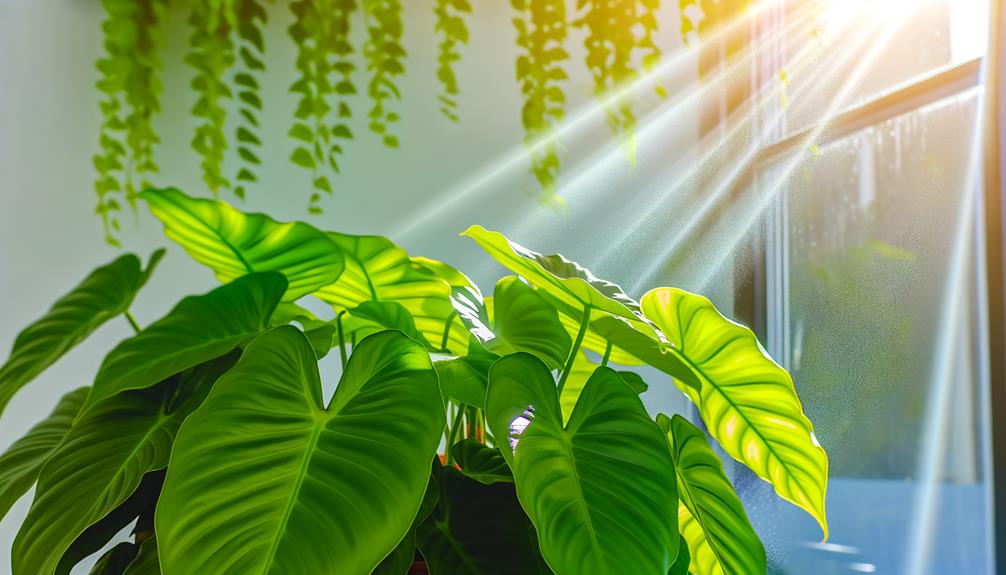
Key Takeaways
- Provide bright, indirect light to avoid leaf scorch and ensure robust growth.
- Maintain consistently moist soil, allowing the top inch to dry out between waterings.
- Use well-draining soil with organic matter to enhance nutrient availability.
- Keep humidity levels between 60% and 80% to mimic its tropical habitat.
- Fertilize bi-monthly with a diluted 20-20-20 water-soluble fertilizer during the growing season.
Light Requirements
Philodendron bipinnatifidum, commonly known as the Tree Philodendron, thrives in bright, indirect light, which ideally replicates its native tropical understory conditions. Best light exposure assures robust photosynthesis, promoting healthy foliage and vigorous growth. Inadequate light can lead to leggy, weak stems and smaller leaves, indicating less than ideal energy conversion.
On the other hand, direct sunlight can cause leaf scorch and chlorosis, hindering the plant’s physiological functions. For indoor cultivation, placing the plant near an east-facing window or using sheer curtains to soften sunlight can achieve the necessary light levels. Moreover, artificial grow lights with a balanced spectrum can supplement natural light, especially in lower-light environments.
Sufficient light management is key for maintaining the ornamental and physiological health of Philodendron bipinnatifidum.
Watering Needs
Proper watering is crucial for maintaining the health and strength of Philodendron bipinnatifidum, as inconsistent moisture levels can lead to root rot or dehydration. This tropical plant thrives in consistently moist soil but should never be waterlogged.
Water the plant thoroughly, allowing excess water to drain, and ensure the top inch of soil dries out between waterings. Adjust watering frequency based on seasonal changes; reduce in winter when growth slows. Employing a proper watering schedule can optimize the plant’s growth and well-being.
| Season | Frequency | Notes |
|---|---|---|
| Spring | Once a week | Increase as growth accelerates |
| Summer | Twice a week | Higher evaporation rates |
| Fall | Once a week | Maintain consistent moisture |
| Winter | Every 10-14 days | Reduced growth and water needs |
| All Seasons | Check soil moisture | Avoid waterlogging and dehydration |
Soil Conditions
Philodendron Bipinnatifidum flourishes in a well-draining soil mix that prevents waterlogging and promotes root health.
Adding organic matter, like peat or compost, improves nutrient availability and soil structure.
Furthermore, maintaining a slightly acidic to neutral pH level, ideally between 5.5 and 7.0, promotes peak nutrient uptake.
Well-Draining Soil Mix
A superior soil mix for Philodendron bipinnatifidum should prioritize well-draining properties to prevent waterlogging and root rot. This can be achieved through a balanced combination of organic matter, perlite, and coarse sand. The inclusion of perlite enhances aeration and drainage by creating air pockets, while coarse sand aids in preventing compaction and facilitates water movement.
This carefully calibrated mix ensures that excess moisture is efficiently expelled, thereby maintaining an ideal moisture level conducive to root health. Additionally, it is crucial to select high-quality, sterile components to mitigate the risk of introducing pathogens or pests.
Organic Matter Inclusion
Incorporating organic matter into the soil mix not only enhances its nutrient profile but also improves moisture retention and soil structure, thereby creating an ideal growth environment for Philodendron bipinnatifidum.
Organic matter such as compost, decomposed leaf litter, and well-aged manure provides a slow-release nutrient source, stabilizing soil pH and promoting beneficial microbial activity. This addition helps prevent soil compaction, promoting strong root development and aeration.
| Organic Matter Type | Primary Benefits | Application Rate |
|---|---|---|
| Compost | Nutrient enrichment, soil texture | 20-30% of total soil volume |
| Decomposed Leaf Litter | Enhanced drainage, moisture retention | 10-15% of total soil volume |
| Well-Aged Manure | Improved microbial activity | 10-20% of total soil volume |
This strategic incorporation guarantees sustained plant health and robust growth.
Ph Level Preferences
Understanding the ideal pH range for soil is essential for ensuring the health and growth of Philodendron bipinnatifidum, as it directly influences nutrient availability and microbial activity. Best soil pH for this species typically falls between 5.5 and 6.5, which is slightly acidic.
A pH within this range facilitates the efficient uptake of essential nutrients such as nitrogen, phosphorus, and potassium, while promoting beneficial microbial processes. To maintain this pH, regular testing and adjustments using sulfur or lime may be necessary.
Additionally, incorporating organic matter can help buffer pH fluctuations. Ensuring the correct pH not only enhances plant health but also supports a thriving ecosystem within the soil, ultimately fostering robust growth and vigor.
Humidity Levels
Maintaining appropriate humidity levels is essential for the best growth and health of Philodendron Bipinnatifidum.
The ideal humidity range for this species is between 60% and 80%, which can be achieved through various methods.
Techniques for increasing humidity levels include the use of humidifiers, pebble trays, and regular misting of the plant’s foliage.
Ideal Humidity Range
To ensure ideal growth for Philodendron Bipinnatifidum, it is essential to maintain a humidity level between 60% and 80%, as this mimics its native tropical environment. This range promotes optimal physiological processes such as transpiration and gas exchange, which are critical for photosynthesis and nutrient uptake.
Low humidity levels can lead to desiccation of the foliage, resulting in browning leaf edges and stunted growth. Conversely, excessively high humidity can encourage the proliferation of fungal pathogens.
Regularly using a hygrometer to monitor indoor humidity can provide valuable data, ensuring that the microenvironment remains within the desired range. This proactive approach supports the health and longevity of the plant, thereby fulfilling the commitment to providing exceptional care.
Increasing Humidity Levels
One efficient method for increasing humidity levels around Philodendron Bipinnatifidum is to use a humidifier. A humidifier can precisely regulate and elevate moisture in the air to the best range. This is particularly crucial for indoor environments where ambient humidity may be lacking.
Additionally, placing a tray filled with water and pebbles beneath the plant can create a localized humid microclimate as the water evaporates. Grouping plants together can also enhance ambient humidity through collective transpiration.
Regular misting, though less steady, can provide temporary relief. Implementing these strategies can notably enhance the plant’s health by preventing issues like leaf browning and promoting ideal growth conditions.
Monitoring humidity levels with a hygrometer guarantees maintenance within the perfect range of 60-80%.
Temperature Range
Philodendron bipinnatifidum thrives best within a temperature range of 65°F to 80°F (18°C to 27°C), which closely mimics its native tropical environment. Maintaining this temperature range is essential for best physiological processes such as photosynthesis and respiration.
Temperatures below 55°F (13°C) can induce stress, leading to stunted growth and potential leaf damage. Conversely, exposure to temperatures exceeding 85°F (29°C) may cause dehydration and chlorosis. Consistent temperature regulation, avoiding abrupt fluctuations, guarantees the plant’s metabolic stability.
For those aiming to create an ideal indoor habitat, position the plant away from drafts, air conditioning vents, and direct heat sources. Using a digital thermostat can assist in monitoring ambient conditions accurately, thereby safeguarding the plant’s health and promoting robust growth.
Fertilization Tips
In addition to maintaining ideal temperature conditions, providing appropriate fertilization is crucial for the sustained health and robust growth of Philodendron bipinnatifidum.
A balanced, water-soluble fertilizer with an N-P-K ratio of 20-20-20 is recommended, applied bi-monthly during the growing season. Dilute the fertilizer to half-strength to prevent root burn.
During the dormant winter months, reduce fertilization to once every two months to avoid overfeeding, which can lead to nutrient imbalances and reduced plant vitality.
Organic options, such as compost or worm castings, can also be incorporated to enhance soil fertility and microbial activity.
Monitoring leaf color and growth rate will provide insight into the plant’s nutritional needs, ensuring optimal care and attention to this tropical species.
Pruning and Maintenance
When considering the pruning and maintenance of Philodendron bipinnatifidum, understanding the plant’s natural growth habits and identifying the best times for intervention are important for maintaining its aesthetic and health.
Regular pruning helps control its size and encourages a more balanced form. It is vital to sterilize pruning tools to prevent the spread of pathogens. Focus on removing yellowed, damaged, or dead leaves to enhance airflow and reduce disease risk.
Use sharp, sterilized pruning shears for clean cuts. Prune during the plant’s active growing season, typically spring and summer. Avoid excessive pruning to prevent stress on the plant.
Conclusion
Despite its seemingly intricate care requirements, Philodendron bipinnatifidum ironically thrives with minimal human intervention in its natural habitat. This paradox underscores the plant’s resilience and adaptability, challenging the meticulous efforts to replicate its ideal environment.
Therefore, the pursuit of perfection in its care may, in fact, be an exercise in futility, highlighting nature’s ability to flourish independently of human interference.

